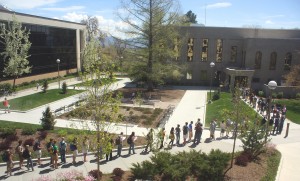
The era of long lines at the Testing Center might be coming to an end at finals.
BYU currently has the largest testing center in the nation, but torturous lines still drain the confidence of those who stand in them to take tests.
The BYU Testing Center is in the process of employing a new policy this semester in order to provide a better “culminating experience.” The new policy, which has not yet been finalized, specifies that all classes having a total of 60 or more students will continue to use the Testing Center for finals. This includes classes with fewer than 60 students but with multiple sections.
Finals for all classes with 59 students or fewer will now be held in the same room the class is taught in. The only exception to the rule will be religion courses, which will continue to be administered by the Testing Center but will most likely continue to be held in other buildings.
Jeffrey D. Keith, associate academic vice president, has discussed the current Testing Center situation with other deans and wants all students to have the best possible final exam experience. “The best experience generally occurs with a proctored exam or experience given in the same location where the class is held,” Keith said in an email sent to select BYU faculty members.
The new policy will affect the majority of BYU classes. According to the Y facts website, as of this year, close to 90 percent of classes at BYU have fewer than 60 students.
David Wright, associate chair of the Mathematics Department, believes the change in procedures will not affect him significantly. “I believe most of us give our exams in the classroom already,” Wright said. “I want to be there when my students are taking their finals. I think most of us do.”
Deborah Himes, current Ph.D student and instructor in the College of Nursing, also believes the nursing program will not be significantly affected. Himes teaches several sections, including at least one with fewer than 60 students, but said typically those classes don’t have a written final.
“My sections that are under 60 students usually don’t have tests for their final… usually I have my students do case studies or give presentations,” Himes said.
Many of the colleges seem to have been practicing the policy before it was ever made. Still, many are not accustomed to having a final conducted in class.
Some students like having several days to take their final. However, not many enjoy waiting in line for several hours.
Final testing is also a busy time for instructors. End-of-semester grading piles up, and adding an in-class final would only further complicate their schedules.
The good news for those professors and their students is that the university understands how hectic finals can be and has provided resources to mitigate the situation.
First, the Testing Center will provide bubble sheets for all in-class finals that can be scored at the Testing Center. The results will then be posted online. The second resource allows the instructors to petition to their deans for an exemption if the instructor or the class has any extenuating circumstances.
Most colleges and universities have been using their testing centers in a similar fashion for years, but this policy may present a big change for BYU.
The policy may take getting used to, but many will be grateful for a change the next time the Testing Center lines reach the Joseph Smith Building.




